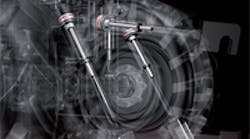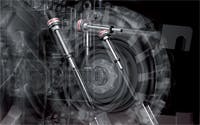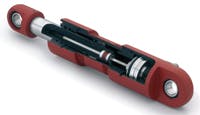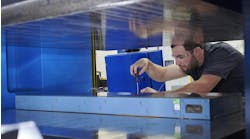Off-highway equipment has seen a significant increase in the use of electronics and electrohydraulic control. Driving this trend are demands to increase machine productivity, provide greater machine performance, and improve operators’ comfort and productivity. These demands — combined with rising fuel prices, cost of inputs (fertilizer, seed, asphalt, concrete, pesticides, etc.), and environmental and safety regulations — have created a need for electrohydraulic automation in mobile equipment, which, in turn, requires reliable electronic feedback of cylinder position. The most popular means of meeting this need is with an in-cylinder linear displacement transducer (LDT).
Off-highway requirements
Off-highway equipment demands rugged position LDTs that will withstand high shock and vibration, and operate under extreme temperature ranges while protected from the harsh climatic conditions where the equipment is operated. But survivability isn’t enough. The equipment also requires an LDT that provides an absolute measurement that is accurate and, more importantly, repeatable.
These might seem to be simple goals to achieve. However, the measurement range (cylinder stroke) on any given machine can vary from 100 mm to 8 m or more. It is imperative that the LDT conforms to these requirements at an acceptable price.
Benefits of magnetostrictive sensors
The growing demand for magnetostrictive LDTs as the position feedback solution in off-highway equipment is attributed to the core capabilities inherent in the technology.
Non-contact operation — Magnetostrictive LDTs have no contact between moving parts, so they are not susceptible to wear. This is essential for reliable operation, especially under the extreme conditions of off-highway equipment.
Absolute measurement — Magnetostrictive LDTs are absolute, so they always report a true position measurement relative to a fixed point. Unlike incremental sensors, which report a relative position to a previous measurement, if power is removed from a magnetostrictive LDT, it will begin reporting the true position once power is restored. Incremental sensors often require a homing procedure to relearn their location.
Repeatability — Magnetostrictive LDTs have excellent repeatability compared to other technologies. Repeatability is critical to having stable control algorithms that produce smooth machine motion. It is also highly important when certain functions on the machine always need to be performed at a specific location, such as centering a steered rear axle before transport on the highway.
EMI resistance — Magnetostrictive LDTs that use a torsional tape pickup can produce an output with a high signal-to-noise ratio, which can improve the sensor’s ability to withstand electromagnetic interference.
Measurement range — Magnetostrictive LDTs accommodate a broad range of strokes — from 50 mm to 20 m — using the same sensor technology. These core capabilities of magnetostrictive sensors make them a better fit than alternative technologies for many applications including agricultural, construction, mining, waste handling, military, and other off-highway applications.
Myths of magnetostriction
Historically, magnetostrictive sensors were not necessarily the best fit for off-highway equipment. Their original design was for industrial environments that required only moderate durability but very precise output compared to off-highway equipment. Industrial temperature requirements were just 85°C on the high end, and shock and vibration resistance was generally lower. Resolution, repeatability, and update rate requirements were higher, more precise, and faster for industrial machines than was needed in off-highway equipment.
For these reasons, manufacturers of off-highway equipment felt that using magnetostrictive transducers would cause them to pay for functionality and precision they didn’t need. Unfortunately, many of the misconceptions that grew out of these early models have persisted, even though off-highway equipment has matured with electrohydraulic controls. Furthermore, development of magnetostrictive technology has eliminated these obstacles. So the needs of electrohydraulically controlled off-highway equipment and the functionality of magnetostrictive LDTs have met on common ground.
Myth 1 — Magnetostrictive sensors will not fit in welded cylinders with clevis mounts.
Unlike the welded, clevis-mount cylinders widely used in off-highway equipment, traditional tie-rod industrial hydraulic cylinders have an open area on the end cap. Because of this, LDTs for industrial applications were designed to access the cylinder from the cap end. This design generally prevented magnetostrictive LDTs from being able to physically fit into off-highway equipment.
Some technologies place the sensing element inside the cylinder and house the electronics remotely. However, this setup makes the sensor more susceptible to electromagnetic interference (EMI) and creates the potential for physical damage. In addition, this method breaks the sensor into two parts, introducing more points for water intrusion or connection problems. With updated designs, magnetostrictive LDTs can now be a compact and fully embedded sensor that is protected to maintain electrical performance.
Myth 2: Magnetostrictive sensors cannot handle high vibration and shock.
Magnetostrictive LDTs have always been known for their ruggedness in industrial applications. However, the vibration and shock of off-highway equipment are more severe. Combining the existing industrial ruggedness with technology, design, and packaging advancements, magnetostrictive sensors have now proven highly tolerant of the high levels of shock (100 G) and vibration (20 GRMS) typically seen in off-highway equipment.
Myth 3: Magnetostrictive sensors are susceptible to EMI.
Historically, magnetostrictive sensors have not met the EMI requirements for off-highway equipment. Through modifications in electronics, magnetostriction has been able to successfully meet 100 V/m requirements and has also shown that 200 V/m is achievable when required. The fully embedded design helps with meeting these requirements because no lowlevel signals are sent external of the sensor or cylinder.
Myth 4: Magnetostrictive sensors have a lot higher resolution than is needed by off-highway equipment.
Traditionally, off-highway equipment has not needed high resolution in sensors because positioning accuracy of only about 1/8 in. was good enough. With the impact of more electronics in the machinery and electrohydraulic controls becoming the norm, electrohydraulic systems are poised to take advantage of a higher resolution sensor.
Does everyone need the higher resolution? No, but some manufacturers are already using every bit of the resolution that off-highway magnetostrictive LDTs can provide. Magnetostrictive LDTs for off-highway equipment are capable of 0.1-mm resolution. Other technologies may be able to achieve 0.5 mm, at best. Although this may be sufficient now, the future will bring tougher requirements. Unlike other technologies, which are at their upper limit of capability, off-highway magnetostrictive LDTs have room for upgrading in the future because the resolution has been optimized to achieve the cost targets.
Now and in the future
Although magnetostrictive technology may have been considered a poor choice for off-highway applications, advances in design and technology have brought the sensors in line with the needs of off-highway equipment. More importantly, unlike other available technologies, magnetostriction still has untapped breadth of capability that will drive the evolution of closedloop control systems of off-highway equipment in the future.
Brian Cox can be reached at (919) 677-2355 or via e-mail at [email protected].



